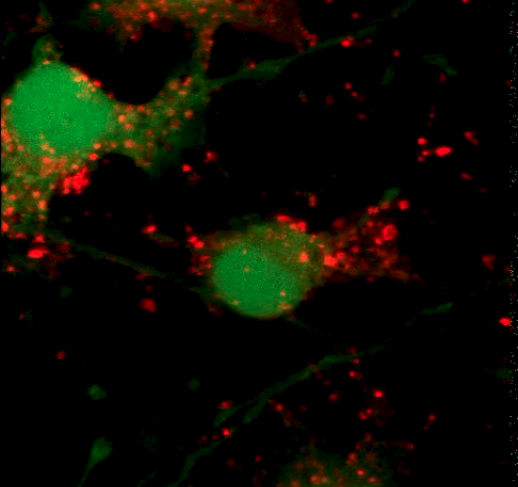
Exosomes and other microvesicles (red) surrounding nearby cells (green)
Exosomes, the small—normally only 30–100 nano-meters across—extracellular vesicles released from cells are not only carriers of cellular waste, as once believed, but also now known to facilitate cellular functions important to survival such as cell-to-cell communication and immunological responses.
Potential for Exosomes in Medicine
Once released from their cells, circulating exosomes can be found in nearly all bodily fluids including blood, urine and saliva. Because exosomes carry surface and cytoplasmic proteins and messenger and micro RNA explicit to their cells of origin, the presence of a disease can be detected through the exosomes released by an infected cell.
Exosomes have been implicated in metastasis or the spreading of cancers; metabolic conditions, like diabetes and obesity; multiple sclerosis and even Alzheimer’s disease. Exosomes can travel long distance and target specific cell types to deliver interfering RNA (siRNA) or pharmaceutically active substances. As such, exosomes are being explored as a means of drug delivery.
Stem Cell–Based Exosomes
Stem cell–based exosomes have been shown to exude some of the same therapeutic benefits as the cells which they are based. Cord blood secretes exosomes in greater levels than bone marrow, indicating cord blood is the ideal candidate for the production of exosomes.
Mesenchymal-based exosomes, similar to those derived from cord tissue, have been shown to be as potent as parent stem cells in the regeneration of various organ injuries by modifying the function and phenotype of cells.
Umbilical cord blood–derived exosomes may accelerate the healing of epidermal tissue, enhance angiogenesis and reduce scar formation of cutaneous wounds. In addition, they’ve been shown to promote collagen and elastin synthesis in the skin, showing the potential for the integration of umbilical cord blood–derived, stem cell–conditioned media (USC-CM) with cosmetics or therapeutics.